Breast milk (BM) is the natural choice of nutrition for most infants around the world. Breast feeding continues to be the single most important intervention in preventing infant and under 5 mortality rates in most developing countries [1,2]. Recent research has revealed that BM has a role in protection against many childhood and adulthood diseases like hypertension, diabetes and obesity [3], besides improving learning and intelligent quotient. Despite its superiority in terms of its contents, cost effectiveness and the bonding it creates between the mother and her infant, it is still impossible to achieve 100% exclusive breast feeding in many developing countries. National Family Health Survey of India (2005-06) indicates that the exclusive breast feeding rates among Indian children aged 0-5 months is only 46.3% and there is not much difference between rural and urban population and for Tamil Nadu state the rates are slightly better at 55% but still unsatisfactory [4]. Exclusive breast feeding is hindered by the practice of administering prelacteal feeds which is seen in almost 50% of babies delivered in one study [5]. In a study conducted in Puducherry in 2009, gripe water was the commonest (55%) non nutritive preparation that was administered to infants by their mothers [6]. The use of gripe water has neither been scientifically studied nor approved by drug regulatory authorities for use in infants, yet it is freely available as over the counter product. In order to ascertain why mothers use gripe water in their infants and to find out what benefits or health risks it poses, we proposed to study the use of gripe water in infants aged 1-6 months.
The Aims of the study are to find out the prevalence of gripe water use among infants1-6 months of age, to find out the reasons for administering it and health consequences associated with its administration.
Materials and Methods
All mother-baby (1-6months) dyads who attended “Well Baby Clinic” of our Paediatric department, during May 2011 to June 2011 and who consented to participate formed the study subjects. After collecting data regarding their age, educational status, employment details, type of family and per-capita income, and all the mothers were subjected to a pre-tested, semi-structured questionnaire by the investigator. For this study, the following definitions were used.
Colic: Paroxysms of irritability, fussing or crying lasting for 3 or more hours in any 1 day and occurring on 3 or more days in any 1 week [7].
Constipation: Interval between stools extending beyond 48 hours and/or passing hard stools associated with crying [8].
Regurgitation or vomiting: Regurgitation (return of small amounts of swallowed milk during or shortly after feeding) more than 4 times a day or vomiting (complete emptying of the stomach, often occurring sometime after feeding) even once a day [8].
Statistical Analyisis
Depending on whether GW was administered or not, the study population was divided into two groups. The various demographic parameters and clinical indicators were compared between the two groups for statistically significant difference. The results were analysed using statistical package SPSS version 13. Prevalence was expressed in terms of percentage and ratios. Odds ratio was used to test the significance of gastro-intestinal and other health problems between the two groups (those who get and those who do not get gripe water). To compare the weight gain between the two groups, Un-paired t-test was used.
Results
A total of 494 children were seen in our Well Baby Clinic during the study period; out of which a total of 386 mothers (of infants 1-6 months) were eligible to be enrolled for the study, but only 361 mothers were willing to participate. However, only 335 mothers returned the completed questionnaire and hence included in the study (STROBE FLOW CHART enclosed as [Table/Fig-1]. Most mothers (55.2%) were between 21-25 years of age. Out of 335 mothers, 191 (57%) were first time mothers and 144 (43%) were multi-parous. Most mothers were educated up to high school level (43.9%) and higher secondary level (26.3%). Majority of mothers belonged to upper-lower socioeconomic class. Most of them (57%) belonged to nuclear family and only 3 families were living together for more than 3 generations. Most of these mothers (90.4%) were unemployed and looked after household chores. The number of mothers who were aware of benefits of exclusive breast feeding and who practiced Exclusive Breast Feeding was 35.82%. The mean age of babies was 2.5 months. Most babies were born by spontaneous vaginal delivery. The average birth weight of babies was 2.7 kg. The number of babies who were completely immunized with age appropriate immunizations was 230 (68.65%). The most commonly administered non-nutritive substance other than breast milk was gripe water which was seen in 64.18 % of the population [Table/Fig-2]. The most common reason for adminsitering gripe water was due to the belief that: i) it helps in digestion -176 responses (81.86%) followed by; ii) it prevents stomach ache - 60 responses (27.90%); iii) insistence of elders - 39 responses (18.13%); and iv) it is good for health - 33 responses (15.34%) respectively [Table/Fig-3]. Most mothers administered GW atleast once a day.
Showing inclusion and exclusion of study subjects as per STROBE compliance flow diagram
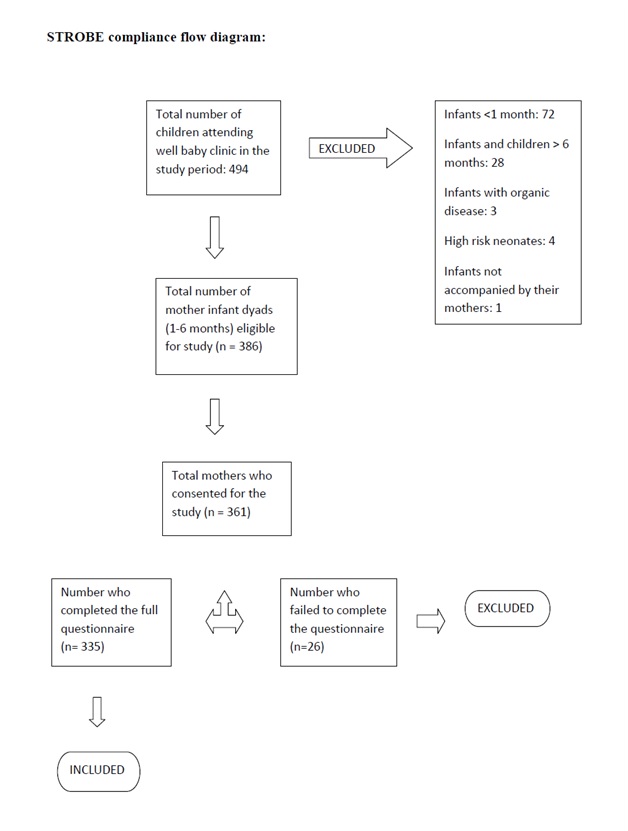
Image showing distribution of gripe water usage among study population
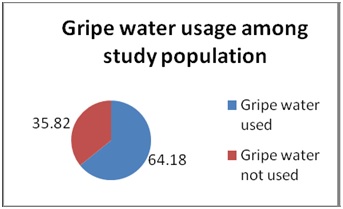
Image depicting reasons for administering gripe water
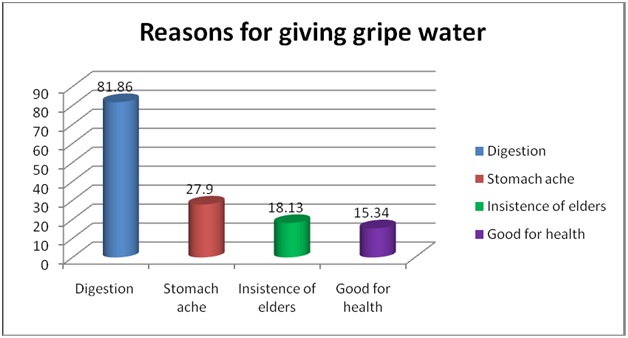
Among babies who were not given GW, the most common reason for not administering it was because of: i) their doctor’s advice - 73 responses (60.83%), followed by; ii) lack of information on its use - 19 responses (15.83%); iii) felt to be a harmful practice - 17 responses (14.16%); iv) felt to be useless - 15 responses (12.5%) respectively [Table/Fig-4]. Among babies receiving GW, the common health problems for which medical attention was sought in the past were cough and cold which was seen in 116 (53.95%) infants, fever seen in 43(20%) infants, hard stools in 42 (19.53%)and loose stools in 24(11.16%) of infants. For the babies who did not receive GW, the most common reasons for seeking medical attention were cough and cold in 50 (41.66%) infants, fever in 16 (13.33%) infants, constipation in 7(5.83%) infants and loose stools in 5(4.16%) infants [Table/Fig-5].
Image depicting reasons for not administering gripe water
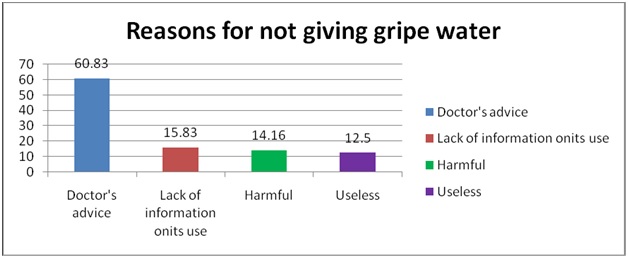
Image showing health problems associated with gripe water use
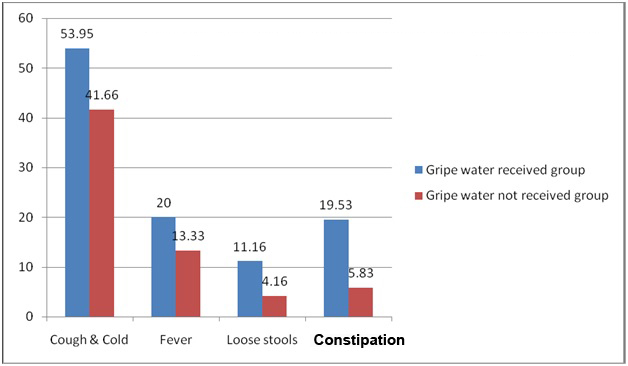
Out of 215 babies who received GW, acceptable weight gain was seen in only 121 (56.27%). Babies in comparison to 75 (62.5%) out of 120 babies who did not receive GW and who were exclusively breast fed. The observed difference was not statistically significant (p-value 0.268). Persistent and prolonged crying diagnostic of infantile colic was seen in 29 babies who were on gripe water compared to only one in the no gripe water group, with a p-value of 0.0001 (OR: 18.5538; 95% CI: 2.4941 -138.0222) [Table/Fig-5]. Regurgitation of feeds was seen in 2 babies in gripe water group compared to 5 babies in “no gripe water” group and vomiting was seen in 12 babies belonging to gripe water group compared to only 3 in “no gripe water” group, with a p-value of 0.0373 (OR: 2.3054; 95% CI: 0.6375-8.337) [Table/Fig-5]. The number of infants who had constipation was significantly more in the gripe water group (19.53%), compared to “no gripe water” group (5.83%), with the p-value of 0.0007 (OR: 3.9191; 95% CI: 1.701-9.0287) [Table/Fig-6].
Image depicting common gastro-intestinal problems associated with gripe water administration
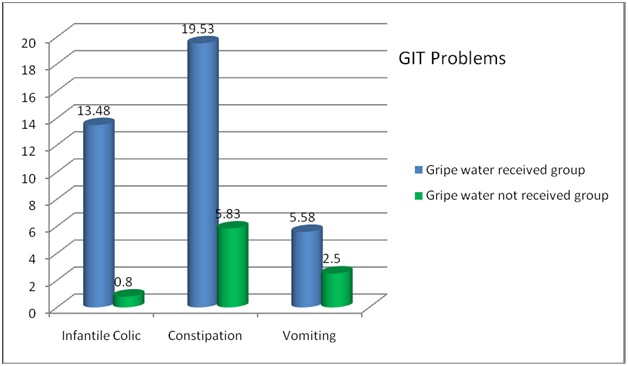
Discussion
The prevalence of gripe water administration in the present study (64.18%) is in agreement to a earlier study in the same geographical region [6]. The demographic profile of the present study has several similarities with earlier studies. There was no significant difference in the age of mother, parity, educational level between the two groups. Most infants were brought up in nuclear family. Of all mothers who used gripe water, 18.13% used it on the insistence of elders. In the present study, we also find that the number of babies who were exclusively breast fed was only 35.82% which is lesser than the national average of 46.3% and number of infants who were completely immunized was 68.65% which is higher than the national average of 44% [4].
Another interesting data that emanates from the present study is that the mothers who were aware of the benefits of exclusive breast feeding were more likely to continue to breast feed their infants exclusively. This finding highlights the importance of counseling the mothers in the antenatal period itself about the importance of exclusive breast feeding. In one North Indian study, 86% of mothers had received counseling regarding infant feeding practices in their antenatal period and it had resulted in more than 80% of their babies being exclusively breast fed until atleast four months of age [9]. The most common reason for administering gripe water in the present study was found to be the belief that it aids digestion and it prevents stomach ache. On the contrary, we have observed that most infants who received GW, continued to cry excessively (suggestive of colic) compared to those who did not receive it. And this shows that the administration of GW may not be able to prevent excessive crying during infancy due to colic. Similarly, the number of babies who had vomiting and constipation were more in the GW group compared to “no GW” group. Hence it is clear that GW administration is a risk factor for vomiting and constipation as it contains non proprietary medications in it, the pharmacological action of which remains to be proven. More number of infants in the GW group required hospital visits in the past for cough, cold, and fever and diarrhea episodes compared to “no GW” group; however the difference was not statistically significant. Since it is a well known fact that exclusive breast feeding reduces the incidence of respiratory infections and diarrheal illnesses in infancy, the reason for the increased number of infants seeking medical treatment in the GW group can be attributed to the lack of exclusive breast feeding in these children. No significant difference in weight gain was observed in both groups. Apart from soothening agents like alcohol and sugar, GW has been known to be contaminated with organisms like pseudomonas and cryptosporidium which can cause serious illness in administered infants. [10]
GW use continues to be a major threat to exclusive breast feeding in this geographical area. The reasons for its continued use are due to certain misconceptions that are prevalent among mothers who use them. GW use does not confer any advantage to the baby in preventing colic nor does it help in digestion, the two most common reasons quoted by mothers who use it. Vomiting and constipation are significant problem in babies who are administered GW, which could also lead to unnecessary investigations like thyroid function tests and abdominal radiographs, by the treating physician. In addition more infants who received GW had also received medical attention for common ailments like cough, cold and fever. Health education to all mothers about the possible harmful effects of gripe water use in infants should be initiated at the antenatal period itself so that the mothers are fully aware of safe and healthy feeding practices to be adopted in feeding their infants. Prospective studies with large sample size and long term follow-up is required to fully understand the effects of GW use in children.
Conclusion
GW is the commonest non nutritive substance that is administered to infants in the first year of life. The use of gripe water in infancy is not approved and not been scientifically studied. From our study we find that GW administration does not prevent excessive crying due to infantile colic. Vomiting and constipation are seen in more number of children receiving GW than in those not receiving GW